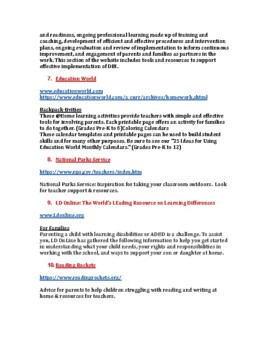Most Useful Educational, Pedagogical, and Parenting Website Resource List
140 Downloads
Exceptional Ed
16 Followers
Grade Levels
PreK - 12th, Higher Education, Adult Education, Homeschool, Staff
Subjects
Resource Type
Standards
CCSSCCRA.L.1
CCSSCCRA.L.2
CCSSCCRA.L.3
NGSSMS-ESS3-2
NGSSMS-ESS3-1
Formats Included
- PDF
Pages
13 pages
Exceptional Ed
16 Followers
Description
My top picks in the best resources out there in the web for teaching, parenting, and navigating the education landscape of the 21st Century at home and abroad.
The following list of websites can be used by both educators and parents to search for information about all topics related to the social, emotional, and intellectual developmental journey of any child.
Evaluate their functions, potential value, and effectiveness in enhancing your teaching, parenting and children’s learning experiences.
Total Pages
13 pages
Answer Key
N/A
Teaching Duration
1 Year
Report this resource to TPT
Reported resources will be reviewed by our team. Report this resource to let us know if this resource violates TPT’s content guidelines.
Standards
to see state-specific standards (only available in the US).
CCSSCCRA.L.1
Demonstrate command of the conventions of standard English grammar and usage when writing or speaking.
CCSSCCRA.L.2
Demonstrate command of the conventions of standard English capitalization, punctuation, and spelling when writing.
CCSSCCRA.L.3
Apply knowledge of language to understand how language functions in different contexts, to make effective choices for meaning or style, and to comprehend more fully when reading or listening.
NGSSMS-ESS3-2
Analyze and interpret data on natural hazards to forecast future catastrophic events and inform the development of technologies to mitigate their effects. Emphasis is on how some natural hazards, such as volcanic eruptions and severe weather, are preceded by phenomena that allow for reliable predictions, but others, such as earthquakes, occur suddenly and with no notice, and thus are not yet predictable. Examples of natural hazards can be taken from interior processes (such as earthquakes and volcanic eruptions), surface processes (such as mass wasting and tsunamis), or severe weather events (such as hurricanes, tornadoes, and floods). Examples of data can include the locations, magnitudes, and frequencies of the natural hazards. Examples of technologies can be global (such as satellite systems to monitor hurricanes or forest fires) or local (such as building basements in tornado-prone regions or reservoirs to mitigate droughts).
NGSSMS-ESS3-1
Construct a scientific explanation based on evidence for how the uneven distributions of Earth’s mineral, energy, and groundwater resources are the result of past and current geoscience processes. Emphasis is on how these resources are limited and typically non-renewable, and how their distributions are significantly changing as a result of removal by humans. Examples of uneven distributions of resources as a result of past processes include but are not limited to petroleum (locations of the burial of organic marine sediments and subsequent geologic traps), metal ores (locations of past volcanic and hydrothermal activity associated with subduction zones), and soil (locations of active weathering and/or deposition of rock).





